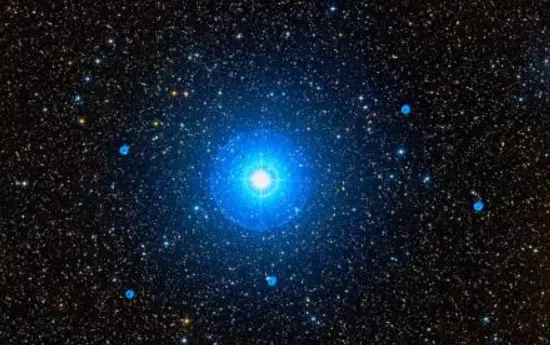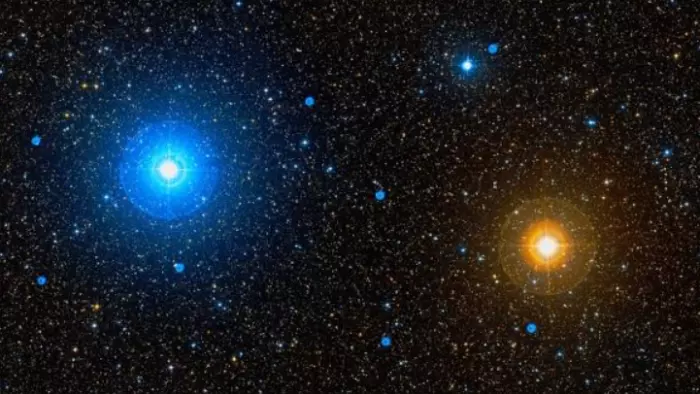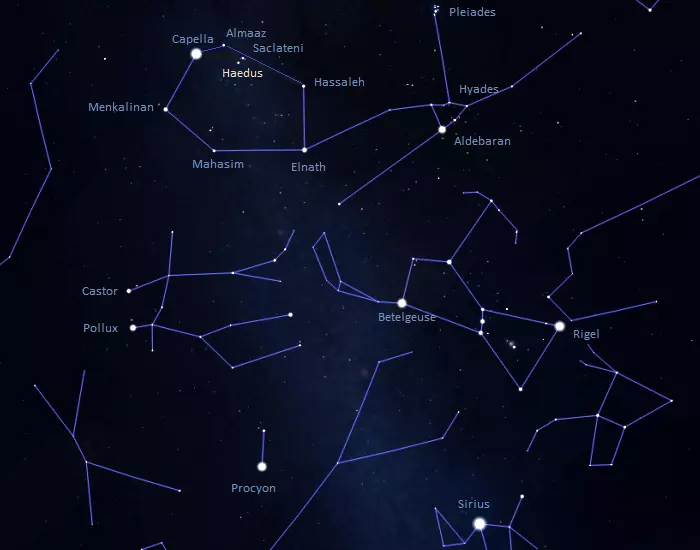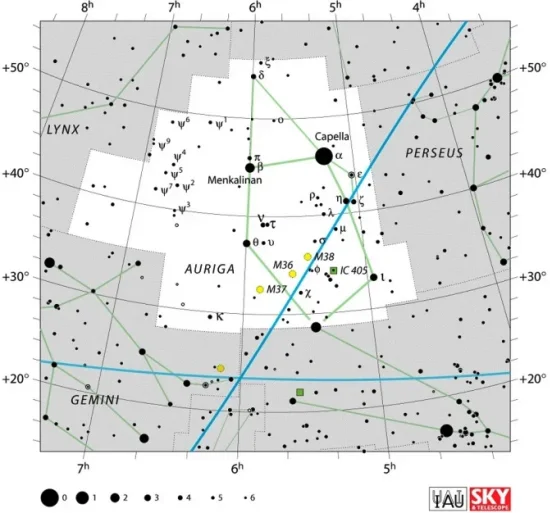Haedus, Eta Aurigae (η Aur), is a hot blue main sequence star located 243 light-years away in the constellation Auriga. With an apparent magnitude of 3.18, it is the sixth brightest star in Auriga. It appears near the bright Capella and is part of an asterism known as the Haedi (the Kids).
Star type
Haedus is a single star of the spectral type B3 V, indicating a hot, blue star that is still fusing hydrogen in its core. The star has a radius of 3.25 solar radii and a mass about 5.4 times that of the Sun. It shines with 955 solar luminosities with a surface temperature of 17,201 kelvin.
Haedus is a fast spinner. With a projected rotational velocity of 95 km/s, it completes a rotation in 1.8 days. The star has an estimated age between 22 and 55 million years.

Haedus (Eta Aurigae), image: Wikisky
Even though it is still a very young star, Eta Aurigae will burn through its supply of hydrogen relatively quickly due to its high mass. However, it is not massive enough to go out as a supernova. Instead, when it reaches the end of its life, it will expel its outer layers to form a planetary nebula. The nebula will be illuminated by the hot central white dwarf that will gradually cool and fade away.
Facts
In Greek mythology, Haedus and the neighbouring Saclateni (Zeta Aurigae) represent the kids of the she-goat Capella. Capella is associated with the goat Amalthea that nursed the infant Zeus and kept him hidden from his father Cronus. Haedus and Saclateni form an asterism known as Haedi, or the Kids. Almaaz (Epsilon Aurigae) is sometimes included in the asterism, but it represents the elbow of the Charioteer and was not historically associated with the Kids.

Eta and Zeta Aurigae (the Haedi), image: Wikisky
Eta Aurigae is a spectral standard for its class (B3V), along with the younger and more massive Alkaid (Eta Ursa Majoris), the star at the end of the Big Dipper’s handle. Haedus serves as one of the stable anchor points used to classify other stars.
Name
The name Haedus (pronunciation: /ˈhiːdəs/) is Latin for “kid.” It refers to one of the two kids of the she-goat Capella. The name comes from the Latin traditional name of Eta Aurigae, Haedus II or Hoedus II. The name Haedus I historically applied to Zeta Aurigae, which now has the formal name Saclateni.
The name Haedus was approved for Eta Aurigae by the International Astronomical Union’s (IAU) Working Group on Star Names (WGSN) on June 30, 2017.
Eta Aurigae once shared the name Mahasim with Theta Aurigae. The name is derived from the Arabic word al-miʽşam, meaning “the wrist” and referring to the wrist of the Charioteer (Auriga). The name now formally applies to Theta Aurigae, one of the bright stars of Auriga’s hexagon.
In Chinese astronomy, Haedus was known as 柱三 (Zhǔ sān), the Third Star of Pillars. Pillars was an asterism within the larger Net mansion, one of the western mansions of the White Tiger. The asterism was formed by Eta Aurigae with Almaaz (Epsilon Aurigae), Saclateni (Zeta Aurigae), Haedus (Eta Aurigae), Upsilon Aurigae, Nu Aurigae, Tau Aurigae, Chi Aurigae, 26 Aurigae, and an unknown ninth star.
Location
Haedus is very easy to find because it appears near Capella, within Auriga’s hexagon. It forms an elongated triangle with Saclateni and Almaaz, the brightest star near Capella.
Capella, the brightest star in Auriga’s hexagon, is part of the Winter Circle (Winter Hexagon), a much larger hexagon-shaped asterism formed by six first-magnitude stars. Other vertices of the Winter Hexagon are marked by Aldebaran in the constellation Taurus, Rigel in Orion, Sirius in Canis Major, Procyon in Canis Minor, and Pollux in Gemini.

The location of Haedus (Eta Aurigae), image: Stellarium
Constellation
Haedus is located in the northern constellation of Auriga. The celestial Charioteer is one of the easiest northern constellations to identify. Its five brightest stars – Capella, Menkalinan, Mahasim, Hassaleh, and Almaaz – form a prominent hexagon with Elnath, the second brightest star in the neighbouring constellation Taurus. Capella, the constellation’s brightest star, is the sixth brightest star in the night sky.
Auriga stretches across 657 square degrees of the northern sky and is the 21st constellation in size. It is one of the 48 ancient constellations catalogued by the Greek astronomer Ptolemy in the 2nd century.

Auriga constellation map by IAU and Sky&Telescope magazine
In Greek mythology, the constellation is associated with two unrelated figures. The first one is Erichthonius, a legendary ruler of Athens who invented the four-horse chariot (the quadriga). The second is Amalthea, the foster mother of the god Zeus, represented as a goat that nursed Zeus when he was an infant.
Auriga contains a number of interesting stars. These include the quadruple star system Alpha Aurigae (Capella), the Algol variables Menkalinan, Almaaz, and Saclateni, the Alpha2 Canum Venaticorum variable Mahasim, the orange giant Hassaleh, and the Orion variable AE Aurigae, the star that lights the Flaming Star Nebula (IC 405).
Auriga also hosts many notable deep sky objects. The brightest of these are the open clusters Messier 36, Messier 37, and Messier 38. The constellation is also home to the open clusters NGC 2281 and the Kite Cluster (NGC 1664), the protoplanetary nebula CRL 618 (the Westbrook Nebula), the emission nebulae IC 417 (the Spider Nebula) and IC 410 (the Tadpole Nebula), and the emission and reflection nebulae IC 405 (the Flaming Star Nebula) and NGC 1931 (the Fly Nebula).
The best time of the year to see the stars and deep sky objects of Auriga is during the month of February, when the constellation appears high above the horizon in the evening sky. The entire constellation is visible from locations north of the latitude 40° S.
The 10 brightest stars in Auriga are Capella (Alpha Aur, mag. 0.08), Menkalinan (Beta Aur, mag. 1.90), Mahasim (Theta Aur, mag. 2.62 – 2.70), Hassaleh (Iota Aur, mag. 2.69), Almaaz (Epsilon Aur, mag. 2.92 – 3.83), Haedus (Eta Aur, mag. 3.18), Saclateni (Zeta Aur, mag. 3.70 -3.97), Delta Aurigae (mag. 3.715), Nu Aurigae (mag. 3.957), and Pi Aurigae (mag. 4.25).
Haedus – Eta Aurigae
| Spectral class | B3 V |
| U-B colour index | −0.66 |
| B-V colour index | −0.18 |
| R-I colour index | −0.17 |
| Apparent magnitude | 3.18 |
| Absolute magnitude | -1.18 |
| Distance | 243 ± 4 light-years (75 ± 1 parsecs) |
| Parallax | 15.8367 ± 0.4714 mas |
| Radial velocity | +7.3 ± 0.7 km/s |
| Proper motion | RA: +28.301 ± 0.952 km/s |
| Dec.: -69.991 ± 0.775 km/s | |
| Mass | 5.4 ± 0.3 M☉ |
| Luminosity | 955 L☉ |
| Radius | 3.25 ± 0.18 R☉ |
| Temperature | 17,201 ± 173 K |
| Age | 22–55 million years |
| Rotational velocity | 95 km/s |
| Rotational period | 1.8 days |
| Surface gravity | 4.13 ± 0.04 cgs |
| Constellation | Auriga |
| Right ascension | 05h 06m 30.8963255794s |
| Declination | +41° 14′ 04.138546013″ |
| Names and designations | Haedus, Eta Aurigae, η Aur, HD 32630, HR 1641, HIP 23767, SAO 40026, FK5 185, BD+41°1058, AG+41 513, GC 6226, GCRV 3018, ALS 8168, CSV 100441, GSC 02899-02237, JP11 974, UBV 4878, IRAS 05029+4110, 2MASS J05063090+4114042, NSV 1822, PLX 1139.00, PPM 47723, TYC 2899-2237-1, Gaia DR2 201261278435365248 |